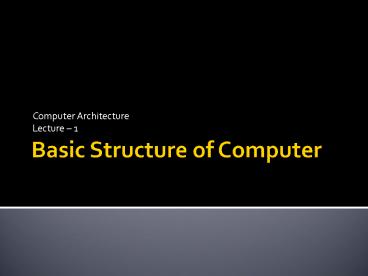Basic Structure of Computer - PowerPoint PPT Presentation
1 / 15
Title:
Basic Structure of Computer
Description:
Computer Architecture Lecture 1 Computer Organization and Design (third edition) David A. Patterson John L. Hennessy Computer Organization (fifth edition) Carl ... – PowerPoint PPT presentation
Number of Views:449
Avg rating:3.0/5.0
Title: Basic Structure of Computer
1
Basic Structure of Computer
- Computer Architecture
- Lecture 1
2
Reference Materials
- Computer Organization and Design (third edition)
- David A. Patterson
- John L. Hennessy
- Computer Organization (fifth edition)
- Carl Hamacher
- Zvonko Vranesic
- Safwat Zaky
- Class Lectures
3
Syllabus(any one section)
- Computer Structure/Architecture
- Operation of Instruction set Execution
- Pipelining
4
Class Tests
- Maximum three class tests
- One will be in very usual way
- One will be sudden (The easiest one, small
syllabus, no memorizing, but the date is unknown
to me too!!!) - If 60 of you(that is, 36) get 80 marks(32) in
above two class tests, only then 3rd class test
will be taken, which will be open material and
the hardest one!!
5
Class Schedule
- From this week to 6th Week.
- Total class 18 2 20
- Total lecture lt 16
- 21 3 ANOTHER WEEK!!! (kept in hand
unfortunately, due to the political and weather
condition of Bangladesh) - Class time lt 40 minutes.
6
Introduction
- Definition of C.A.
- The Architecture of a computer can be defined as
the design of the task-performing part of it. - It also includes the overall fundamental working1
principle of the internal logical structure2 of a
computer system. - So, computer architecture includes
- Instruction set architecture
- Machine architecture
7
Introduction
- Objectives of a Computer architect
- To select, design, interconnect and engineer
hardware components of various levels of computer
that meet functional performance and
programmability maintaining cost and
availability constraint. - So, the total coordination of abstract levels of
a processor under changing forces, involving
design, measurement and evaluation is within the
objectives of a computer architect.
8
Instruction set Architecture
- Instruction set architecture is the attributes of
a computing system as seen by the assembly
language programmer or compiler. - This includes
- Instruction Set (what operations can be
performed?) - Instruction Format (how are instructions
specified?)
9
Instruction set Architecture
- Data storage (where is data located?)
- Addressing Modes (how is data accessed?)
- Exceptional Conditions (what happens if something
goes wrong?)
10
Machine Architecture
- Machine organization is the view of the computer
that is seen by the logic designer. - This includes
- Capabilities performance characteristics of
functional units (e.g., registers, ALU, shifters,
etc.). - Ways in which these components are interconnected
- How information flows between components
11
Machine Architecture
- Logic and means by which such information flow is
controlled - Coordination of functional units Typically the
machine organization is designed to meet a given
instruction set architecture. - However, in order to design good instruction
sets, it is important to understand the how the
architecture might be implemented.
12
Structure Functional Units
- Functional Units
- A computer consists of 3 main functionally
independent units - Input/output(I/O) unit
- Memory
- Processor
- The I/O unit and the processor is again
sub-divided into 2 parts.
13
Structure Functional Units
- The 2 parts of I/O unit
- Input
- Output
- The 2 parts of processor
- Arithmetic and Logic unit
- Control unit
- So, there are main 5 functional units of a
computer.
14
Functional Units
Arithmetic
and
Input
logic
Memory
Output
Control
Processor
I/O
Functional units of a computer.
15
References
- Class Lecture






























